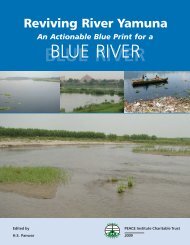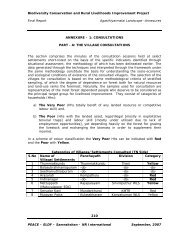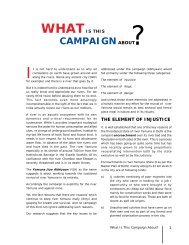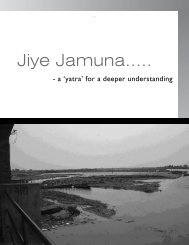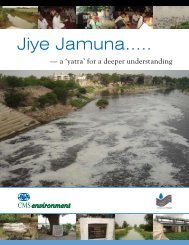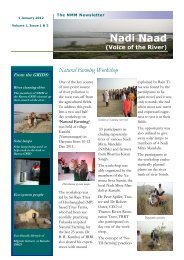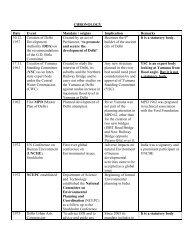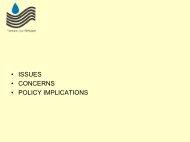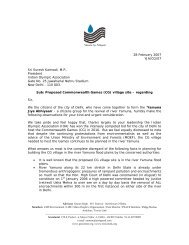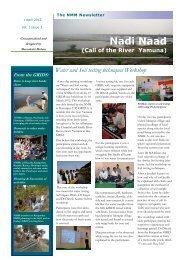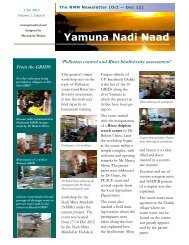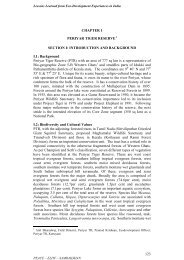1 - PEACE Institute Charitable Trust
1 - PEACE Institute Charitable Trust
1 - PEACE Institute Charitable Trust
Create successful ePaper yourself
Turn your PDF publications into a flip-book with our unique Google optimized e-Paper software.
CITES UPDATE<br />
RRCC – Assisting CITES implementation<br />
in South Asia<br />
Monthly CITES update<br />
Published by<br />
Research and Resource Centre for<br />
CITES (RRCC)<br />
<strong>PEACE</strong> <strong>Institute</strong> <strong>Charitable</strong> <strong>Trust</strong><br />
178-F, Pocket IV<br />
Mayur Vihar I<br />
DELHI – 110091<br />
INDIA<br />
Telefax: 91-11-22719005<br />
E-mail: manojmisra@peaceinst.org<br />
Objectives of RRCC:<br />
In tune with the strategic vision 2005 of<br />
CITES, the RRCC shall endeavour to<br />
become a third party facilitator to help<br />
realise the following CITES vision:<br />
• Enhance the ability of each Party<br />
to implement the Convention.<br />
• Strengthen the scientific basis of<br />
the decision – making processes.<br />
• Contribute to the reduction and<br />
ultimate elimination of illegal trade<br />
in wild fauna and flora.<br />
• Promote greater understanding of<br />
the Convention.<br />
In addition RRCC proposes to:<br />
• Facilitate the implementation of<br />
the Convention in South Asia<br />
• Facilitate interactions between<br />
CITES and other related<br />
multilateral agencies like CMS,<br />
IWC, CBD and WTO<br />
Volume II<br />
Issue 1 January 2006<br />
Advisor: Samar Singh<br />
Editor: Manoj Kumar Misra<br />
Research and production:<br />
Pushp Jain, Sudha Mohan, Tanweer<br />
Muntakhab, Manorama Goswami<br />
Editorial…………<br />
Any entity to function effectively requires<br />
adequate financial and human resources.<br />
CITES is no exception to this fact.<br />
Unfortunately the funding of CITES is<br />
often little understood or appreciated.<br />
CITES being a Convention created for the<br />
Parties and by the Parties requires to be<br />
funded out of contributions made by the<br />
Parties and from additional funds accessed<br />
by the Secretariat from external sources.<br />
A central fund called the CITES <strong>Trust</strong><br />
Fund, finances the core administrative<br />
costs of the Secretariat, the Conference of<br />
the Parties and its subsidiary bodies, the<br />
Standing Committee and the other<br />
permanent committees. This <strong>Trust</strong> Fund is<br />
replenished from contributions from the<br />
Parties to the Convention based on a<br />
United Nations scale (adjusted) of<br />
assessment (www.cites.org). For example,<br />
in the case of Parties from South Asia the<br />
annual contribution to CITES <strong>Trust</strong> Fund<br />
ranges from USD 47 (Bhutan) to USD<br />
15,983 (India).<br />
The CITES Secretariat solicits funds from<br />
national governments and other external<br />
sources for projects and activities which<br />
have been mandated by the Resolutions<br />
and Decisions arrived at a CoP. Presently<br />
funds from external sources have been<br />
sought for 7 different activities resulting<br />
from Decisions arrived at CoP 13 and<br />
related developments.<br />
It is a matter of concern that the budget<br />
related debates at a CITES CoP are often<br />
considered insipid and hence many Parties<br />
at the CoP avoid attending or<br />
understanding what it is purporting to<br />
suggest / recommend. While numbers and<br />
figures might seem daunting to some it is<br />
imperative that Parties not only<br />
participate but make adequate prior<br />
preparations for the budget debates at<br />
Issue No. 1 of Vol. II 1
CITES UPDATE<br />
CoP for ensuring that CITES budget<br />
approved at the CoP is not only cost<br />
effective but also incorporates cost saving<br />
measures.<br />
It is also imperative that all Parties are<br />
prompt in making their committed annual<br />
contributions to the CITES <strong>Trust</strong> Fund. It<br />
is heartening to note that the performance<br />
of Parties in South Asia in making timely<br />
contributions to the CITES <strong>Trust</strong> Fund has<br />
improved considerably over time.<br />
Congratulations.<br />
Wishing all our patrons a VERY HAPPY<br />
NEW YEAR 2006<br />
Manoj Kumar Misra<br />
Glossary of technical terms<br />
(Here we explain in simple language selected<br />
technical terms relating to the Convention which<br />
require better understanding – Editor)<br />
‘Pre – Convention Specimens’<br />
Any specimen which pre dates the<br />
Convention coming into force in 1975 is<br />
termed pre – Convention Specimen in the<br />
event of its entering later an international<br />
commercial transaction. It is thus termed<br />
since the relevant provisions of the<br />
Convention would not get attracted in<br />
respect of it.<br />
Paragraph 2 of Article VII of the<br />
Convention deals with a pre-convention<br />
specimen as under:<br />
‘Where a Management Authority of the<br />
State of export or re export is satisfied<br />
that a specimen was acquired before the<br />
provisions of the present Convention<br />
applied to that specimen, the provisions of<br />
Articles III (Trade in specimens of<br />
Appendix I species), IV (Trade in<br />
specimens of Appendix II species) and V<br />
(Trade in specimens of Appendix III<br />
species) shall not apply to that specimen<br />
where the MA issues a certificate to that<br />
effect.’<br />
In order to prevent misuse of preconvention<br />
specimen clause and to clarify<br />
related issues the matter has been<br />
debated and resolved at various CoPs<br />
(Conf. 4.11 and Conf. 5.11)<br />
CITES News<br />
The 54 th meeting of the CITES Standing<br />
Committee (SC) has been scheduled from<br />
2-6 October 2006 at Geneva<br />
(Switzerland).<br />
(The performance of most CITES Parties from South<br />
Asia in relation to progress made by them in respect<br />
of domestic CITES legislation would come up for<br />
review at the said meeting of SC – editor)<br />
CITES CoP 14 is fast approaching<br />
The CITES CoP 14 has been scheduled to<br />
be held from 3-15 June 2007 in<br />
Netherlands.<br />
(Now while 2007 may seem remote at this point of<br />
time, in view of the fact that a Party wishing to<br />
submit any proposal for consideration at the CoP<br />
need submit the same at least 150 days in advance<br />
of the start of the CoP, June 2007 is not that far<br />
away – editor).<br />
CITES Notifications<br />
(Here we carry the operational part of such<br />
notifications issued by the CITES Secretariat that<br />
bear relevance to the Parties in South Asia – Editor)<br />
Notification No. 2005/067 dated 8<br />
December 2005 deals with Training<br />
presentations<br />
The Secretariat has sent to the Parties two<br />
copies of an ID-ROM (card sized CD-ROM)<br />
with training presentations on CITES. It<br />
contains 16 training presentations in<br />
PowerPoint format, the text of the<br />
Convention, CITES Appendices I, II and<br />
Issue No. 1 of Vol. II 2
CITES UPDATE<br />
III (valid from 23 June 2005) and the<br />
standard CITES export/import permit and<br />
re export certificate.<br />
The PowerPoint presentations include an<br />
introductory section and cover the<br />
following topics:<br />
Definitions, roles of CITES Authorities, role<br />
and function of the Scientific Authority,<br />
permits and certificates, special<br />
procedures, reading the Appendices, using<br />
the Appendices, science, non-detriment<br />
findings and data, role of quotas in CITES,<br />
trade with non-Parties, permit<br />
management systems, filling in permit<br />
forms, reservations and plants.<br />
The Secretariat is aware that a number of<br />
non-governmental organizations now offer<br />
CITES related training to CITES Parties.<br />
Having reviewed some of the<br />
presentations used in such training, the<br />
Secretariat is concerned that in some<br />
cases it appears that out-of-date or<br />
incorrect advice is provided. The<br />
Secretariat wishes to remind Parties that<br />
CITES training conducted by nongovernmental<br />
organizations using<br />
materials other than those distributed by<br />
the Secretariat or by a Party may contain<br />
incorrect or biased interpretation of the<br />
Convention.<br />
Nevertheless, the Secretariat encourages<br />
non-governmental organizations to<br />
support CITES capacity building efforts,<br />
and is willing to work with such<br />
organizations wishing to develop CITES<br />
training materials, to ensure the accuracy<br />
of these materials.<br />
The Secretariat has also updated the CD-<br />
ROM training programme for Customs.<br />
Two copies of this CD-ROM are provided<br />
with the present Notification.<br />
Additional copies of the above-mentioned<br />
ID-ROM and CD-ROM are available on<br />
request from the Secretariat.<br />
Notification No. 2005/069 dated 8<br />
December 2005 deals with<br />
Implementation of Resolution Conf. 12.8<br />
(Rev. CoP13) regarding suspension of<br />
trade with specific Parties<br />
(Recommendations of the Standing<br />
Committee)<br />
As part of the Review of Significant Trade,<br />
the Animals and Plants Committees<br />
regularly make recommendations to<br />
States to ensure that trade in specimens<br />
of Appendix-II species is not detrimental<br />
to them. If Parties fail to implement the<br />
recommendations, or fail to submit the<br />
necessary information to the Secretariat,<br />
the Standing Committee may recommend<br />
that all Parties suspend imports from the<br />
States concerned of specimens of a<br />
particular species.<br />
Over 20 States are currently affected by<br />
such recommendations for suspension of<br />
imports. These States, and the species<br />
involved, are listed on the CITES website<br />
in the section ‘Resources/Trade<br />
suspensions’.<br />
It appears, however, that there have been<br />
a number of instances where Parties have<br />
not implemented such recommendations.<br />
This has led to a situation where the<br />
offspring of specimens obtained against<br />
the Standing Committee’s<br />
recommendations are also now being<br />
traded internationally.<br />
The Secretariat understands that, in some<br />
cases, imports of such specimens may<br />
have occurred inadvertently; for example,<br />
border control agencies may not have<br />
been aware of the recommendation when<br />
shipments were presented for import or<br />
Management Authorities may have failed<br />
to recognize that such recommendations<br />
Issue No. 1 of Vol. II 3
CITES UPDATE<br />
were in force if they were processing<br />
import applications.<br />
In order not to undermine the<br />
recommendations of the Standing<br />
Committee, the Secretariat encourages<br />
Parties:<br />
a) to take steps to ensure that they can<br />
effectively<br />
implement<br />
recommendations of the Standing<br />
Committee; and<br />
b) not to authorize the re-export of any<br />
specimens imported against such<br />
recommendations.<br />
Parties are requested to inform their<br />
enforcement and Customs authorities of<br />
the availability of the list of trade<br />
recommendations on the CITES website in<br />
order to avoid the inadvertent acceptance<br />
of specimens subject to a<br />
recommendation to suspend trade. Parties<br />
that require the issuance of import<br />
permits for trade in specimens of<br />
Appendix-II species are also encouraged<br />
to consult the list when processing<br />
applications.<br />
CITES Resolution<br />
(Here we carry operational parts of such current<br />
Resolutions made at various CoPs which are relevant<br />
to CITES implementation by parties in South Asia –<br />
Editor)<br />
Consultation with range States on<br />
proposals to amend Appendices I and<br />
II (Conf.8.21 as amended at CoP 13)<br />
NOTING that the provisions of the<br />
Convention do not require the prior<br />
support of range States for proposals to<br />
amend Appendices I and II;<br />
RECALLING that the format for proposals<br />
laid down in Resolution Conf. 9.24 (Rev.<br />
CoP13) adopted at the ninth meeting of<br />
the Conference of the Parties (Fort<br />
Lauderdale, 1994) and revised at its 12th<br />
and 13th meetings (Santiago, 2002;<br />
Bangkok, 2004), provides for comments<br />
to be sought from the range States;<br />
OBSERVING that many proposals have<br />
been submitted without such comments<br />
being sought;<br />
RECOGNIZING, however, that for certain<br />
taxa with extensive distributions such<br />
consultation may be difficult;<br />
CONSCIOUS that amendments to<br />
Appendices I and II may affect the<br />
interests of range States;<br />
REMARKING that international treaties<br />
rely for their successful implementation<br />
upon cooperation and mutual respect;<br />
MINDFUL that an additional period of time<br />
may be required to consult with range<br />
States;<br />
THE CONFERENCE OF THE PARTIES TO<br />
THE CONVENTION RECOMMENDS that for<br />
any submission of a proposal to amend<br />
Appendix I or II of the Convention one of<br />
the following two procedures be applied:<br />
a) where the proposing Party intends to<br />
consult the range States, it:<br />
i) advises the Management Authorities of<br />
the range States within which the<br />
species occurs of its intention to<br />
submit a proposal;<br />
ii) consults with the Management and<br />
Scientific Authorities of these States<br />
on the substance of the proposal; and<br />
iii) includes the opinions of these<br />
Authorities in section 6 of the proposal<br />
submitted in accordance with<br />
Resolution Conf. 9.24 (Rev. CoP13)1<br />
except that, where no response has<br />
been received from a range State<br />
within a reasonable period of time, the<br />
proposing Party may instead simply<br />
Issue No. 1 of Vol. II 4
CITES UPDATE<br />
document its attempts to obtain these<br />
opinions; or<br />
b) where prior consultation with range<br />
States will not take place:<br />
i) the Party submits the proposal at least<br />
330 days in advance of the next<br />
scheduled meeting of the Conference<br />
of the Parties;<br />
ii) the Secretariat circulates the proposal<br />
as soon as possible to all Parties; and<br />
iii) interested Parties send their comments<br />
to the proposing Party in order to<br />
allow it to submit a revised proposal at<br />
least 150 days prior to the meeting.<br />
The revised proposal should incorporate<br />
the comments received, in<br />
compliance with Resolution Conf. 9.24<br />
(Rev. CoP13) separating them into<br />
two categories, reflecting the opinions of<br />
range States and non-range States.<br />
CITES Calendar<br />
(Here we carry information about such events in the<br />
CITES calendar which directly impact or relate to the<br />
CITES Parties in South Asia region - Editor)<br />
19 - 20 December 2005: Monitoring the<br />
Illegal Killing of Elephants (MIKE), 3rd<br />
Steering Committee for South Asia Sub<br />
region. Chittagong, Bangladesh<br />
31 December 2005: Deadline for<br />
communication to the Secretariat of<br />
information about export quotas for 2006<br />
for raw ivory in compliance with<br />
Resolution Conf. 10.10 (Rev. CoP12) on<br />
Trade in elephant specimens.<br />
31 December 2005: Parties requested to<br />
submit to the Secretariat, details of<br />
voluntary export quotas established under<br />
the provisions of paragraph a), under<br />
'RECOMMENDS' in section VIII of<br />
Resolution Conf. 12.3 (Rev. CoP13) on<br />
Permits and certificates; (See Notification<br />
to the Parties No. 2005/008 for<br />
background information and instructions).<br />
31 March 2006: Deadline for Asian big cat<br />
range States to submit to the Secretariat<br />
reports describing their implementation of<br />
Resolution Conf. 12.5 (Conservation of<br />
and trade in tigers and other Appendix-I<br />
Asian big cat species). (In South Asia India,<br />
Nepal, Bangladesh and Bhutan would require to<br />
submit the reports as above – editor)<br />
8 July 2006: Deadline for Parties to<br />
submit to the Secretariat proposals to<br />
amend Appendices I and II at CoP14<br />
(Proposals should not exceed 12 pages)<br />
1) without the prior consultation of range<br />
States of the species concerned (see<br />
Resolution Conf. 8.21 on Consultation<br />
with range States on proposals to<br />
amend Appendices I and II)<br />
2) pursuant to Resolution Conf. 11.16 on<br />
Ranching and trade in ranched<br />
specimens of species transferred from<br />
Appendix I to Appendix II.<br />
2 – 6 October 2006: 54 th meeting of the<br />
CITES Standing Committee (SC), in<br />
Geneva, Switzerland<br />
3 – 15 June 2007: 14 th meeting of the<br />
Conference of Parties (CoP), in the<br />
Netherlands.<br />
From CITES World<br />
(Here we carry notable features from the CITES<br />
World, the official newsletter of the CITES – Editor)<br />
(Source: Issue 16, December 2005)<br />
Handling confiscated specimens<br />
The handling of confiscated specimens can<br />
be made easier if one is well-prepared and<br />
well-equipped. A suitably-equipped<br />
location is of utmost importance, as in the<br />
Issue No. 1 of Vol. II 5
CITES UPDATE<br />
case of live specimens there will always be<br />
a risk of an escape. Information should be<br />
kept at hand, such as a list of experts in<br />
animal and plant handling, identification<br />
and care; a list of rescue centres; and the<br />
telephone numbers where the<br />
Management Authority can be reached<br />
(keeping in mind that confiscations often<br />
occur in the evening and at weekends).<br />
Basic equipment can include a bird net,<br />
leather gloves, snake hooks, facemasks,<br />
protective eyewear, surgical gloves, cloth<br />
sacks, a large clean container (such as a<br />
rubbish container with a lid), towels and<br />
blankets, and antibacterial soap.<br />
Handling wildlife can be dangerous, and it<br />
is important to take precautions for your<br />
safety, that of your colleagues, and for the<br />
safety of the specimens. Animals are often<br />
faster and much stronger than might be<br />
expected. Quite apart from the damage<br />
that can be caused by claws, teeth, beaks,<br />
toxins, spines or others, animals can also<br />
carry infectious diseases such as hepatitis<br />
A and B, psittacosis and salmonella. Dead<br />
specimens may also pose a risk, for<br />
instance, hunting trophies may have sharp<br />
claws, talons, horns or antlers, and they<br />
may have been treated with chemicals,<br />
which are poisonous if inhaled. Handling<br />
plants can also be risky, as plants may<br />
secrete toxic substances or have sharp<br />
spines, and they may have been treated<br />
with chemicals and pesticides.<br />
The Secretariat<br />
CITES Resource<br />
(We provide here reference to useful resource<br />
material on CITES – Editor)<br />
2005 Checklist of CITES species now<br />
available (Source: CITES World, Issue 16<br />
December 2005)<br />
The Checklist of CITES species provides<br />
the official alphabetical list of CITES<br />
species, their scientific synonyms, their<br />
common names in English, French and<br />
Spanish (to the extent that these were<br />
available to the compilers) and an<br />
indication of the Appendix in which they<br />
are listed. The publication includes a<br />
CDROM that contains in PDF format all of<br />
the information above as well as the<br />
Annotated CITES Appendices and<br />
reservations. The latter provides the<br />
original listing date of all taxa (orders,<br />
families, genera, species, and subspecies)<br />
and populations specifically named in the<br />
current or past Appendices.<br />
It also indicates all reservations ever<br />
made by Parties, with the dates on which<br />
they entered into force and, in the case of<br />
past reservations, the dates on which they<br />
were withdrawn.<br />
This book should be particularly useful to<br />
CITES Management and Scientific<br />
Authorities, Customs officials and all<br />
others involved in implementing and<br />
enforcing the Convention.<br />
Paper copies can be ordered from the<br />
CITES Secretariat (USD 60 per copy). An<br />
electronic version can be downloaded in<br />
PDF format from the website<br />
(www.cites.org) at no cost.<br />
Field Guide for identification of Fake<br />
Skins of Tiger (Source: Regional Deputy<br />
Director (Wildlife Preservation) Southern<br />
Region, Chennai)<br />
Fakes and counterfeits are the most<br />
dreaded things in the commercial world.<br />
They eat into the legitimate market share<br />
of the genuine businessmen, and divest<br />
the consumers of their hard earned<br />
money. The law expects the enforcement<br />
authorities to protect the interests of the<br />
businessmen and the consumers by taking<br />
action against the unscrupulous persons<br />
introducing fakes and counterfeits in the<br />
Issue No. 1 of Vol. II 6
CITES UPDATE<br />
market. With a multi-billion dollar wildlife<br />
trade in the world, it is not surprising to<br />
find fakes of wildlife items in large<br />
quantities in the market. But the concerns<br />
of the enforcement authorities in this case<br />
are more for protecting the wildlife species<br />
in question than for safeguarding the<br />
interests of the traders and the<br />
consumers. Reckless trade has since long<br />
been identified as a great threat to the<br />
survival of wild fauna and flora. A large<br />
number of countries including India have<br />
enacted legislation that discourages both<br />
sale and purchase of wildlife items.<br />
Fakes are objectionable because they<br />
keep the demand for wildlife items alive.<br />
Fakes are dangerous because they can<br />
mislead the investigators and provide a<br />
cover to the clandestine wildlife trade.<br />
Often it is seen that seizures involving<br />
suspected wild life produce are rushed to<br />
the press with endorsements by senior<br />
levels of agencies effecting seizures. Upon<br />
professional examination, many a time it<br />
turned out to be a fake. The rushing to<br />
press with a fake product at hand has<br />
three consequences:<br />
a) It aberrates the wild life crime scenario<br />
and mars the crime analysis masking the<br />
true trends with potential to cause<br />
diversion of efforts on to wild goose chase<br />
while potential points receive less<br />
attention. In a nutshell it amounts to<br />
calling wolf when it is actually not there<br />
which upon repetition would weaken<br />
response if the wolf actually arrives.<br />
b) It artificially inflates the crime graph<br />
and reflects badly upon the<br />
professionalism of agency involved when<br />
the product upon scientific examination<br />
turns out to be a fake.<br />
c) It adversely affects the investigation<br />
and conduct of the case in the Court of<br />
Law as the provisions and procedures of<br />
law dealing with fake and real are totally<br />
different.<br />
It is, therefore, essential that the<br />
enforcement authorities should be able to<br />
distinguish the fakes from the genuine<br />
wildlife items. It is now possible with the<br />
help of the DNA based tools and other<br />
sophisticated laboratory techniques to<br />
identify any specimen being traded as a<br />
wildlife item. But in many cases, simple<br />
field techniques can provide quick, cheap<br />
and reliable way of identification. A step in<br />
this direction is a Windows based<br />
application CD ROM prepared by Wild Life<br />
Regional Office, Southern Region, titled<br />
“Field Guide for Identification of Fake<br />
Skins of Panthera Tigris” that deals with<br />
the tricky issue of distinguishing genuine<br />
tiger trophies from the fake ones. The<br />
identification tips are based on some<br />
common but unique physical attributes of<br />
tigers, which one can look for on the<br />
specimen under scrutiny with naked eyes.<br />
The guide is divided into two Sections viz.,<br />
LEARN, COMPARE. In the "Learn" section,<br />
the user gets to know about the various<br />
morphological features of tiger crucial for<br />
differentiating genuine from the fake. The<br />
"Compare" section consists of three parts<br />
viz., Identification based on Morphological<br />
Examination, Identification based on<br />
Microscopic Examination of guard hair and<br />
Identification based on Overall<br />
Examination. For a virtual close-up of<br />
various aspects of the fakes vis-à-vis the<br />
genuine, the user can enlarge the images<br />
by clicking the thumbnails. It has been<br />
widely circulated to various Enforcement<br />
Agencies and State Wild Life Departments.<br />
It is hoped that it would be of help to the<br />
field Enforcement officials during their<br />
investigations. (rddsr@vsnl.com)<br />
Recent notable seizures<br />
(We carry here relevant information on recent<br />
seizures of wildlife items from countries in South<br />
Asia region – editor)<br />
Red Sanders (Pterocarpus santalinus)<br />
wood<br />
Issue No. 1 of Vol. II 7
CITES UPDATE<br />
New Delhi: Authorities in Hong Kong<br />
have seized 60 tonnes of Red sanders<br />
wood – used in making musical<br />
instruments and ayurvedic medicine –<br />
smuggled from India recently, pointing to<br />
a large-scale racket operating from<br />
Andhra Pradesh and Tamil Nadu. The<br />
seizures were based on intelligence<br />
provided by the Directorate of Revenue<br />
Intelligence (DRI) to its Hong Kong<br />
counterpart.<br />
In a similar operation in India, DRI seized<br />
180 tonnes of similar wood. The<br />
intelligence agency had notched up a<br />
bigger seizure of 290 tonnes last year.<br />
Sources said the racket has been going on<br />
for last couple of years. The wood, mainly<br />
sources from Rayalaseema region in<br />
Andhra, is smuggled out of the country<br />
using various ports to evade seizures.<br />
(Source: Times of India, 25 Nov 2005)<br />
(Red Sanders is a CITES Appendix II species –<br />
Editor)<br />
Reptile skin<br />
Mumbai: In the largest ever haul in<br />
western India the Directorate of Revenue<br />
Intelligence (DRI) on Tuesday morning<br />
seized 55,000 pieces of snake skin from a<br />
container that was to be loaded onto a<br />
vessel at Nhava Sheva port. The skins<br />
worth Rs 3 crore (.6 million USD) were to<br />
be sent to Singapore.<br />
The consignment had been declared as<br />
chilli powder. On examination the DRI<br />
team found 75 gunny bags full of skins –<br />
of cobra, viper and rat snake – concealed<br />
behind packets of chilli powder. (Source:<br />
Times of India, 22 Dec 2005)<br />
Feedback:<br />
Thanks a lot!<br />
Channa Bambaradeniya, PhD<br />
Coordinator - Regional Species<br />
Programme<br />
Ecosystems and Livelihoods Group 2<br />
IUCN - Asia Regional Office<br />
53 Horton Place<br />
Colombo 7<br />
Sri Lanka<br />
I am extremely thankful to you for<br />
sending me the CITES update.<br />
Dr. S.P. Goyal<br />
Scientist<br />
Wildlife <strong>Institute</strong> of India<br />
Dehradun, India.<br />
Thank you. I am in Spain busy with my<br />
Masters degree course on Wildlife Species<br />
trade and CITES.<br />
Samantha Gunasekhara<br />
Dept. of Customs<br />
Sri Lanka.<br />
Thank for sending CITES UPDATE, It has<br />
quite good information, which is useful for<br />
our purposes. I am looking forward your<br />
next CITES UPDATES.<br />
H.D.Ratnayake<br />
Deputy Director (Research and Training)<br />
Dept. of Wildlife Conservation<br />
Sri Lanka.<br />
Issue No. 1 of Vol. II 8



